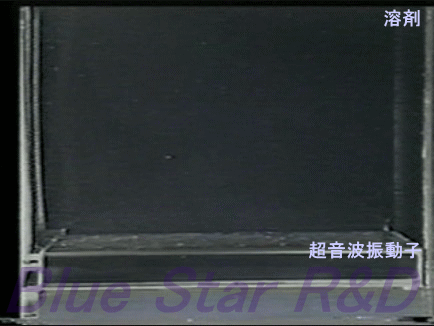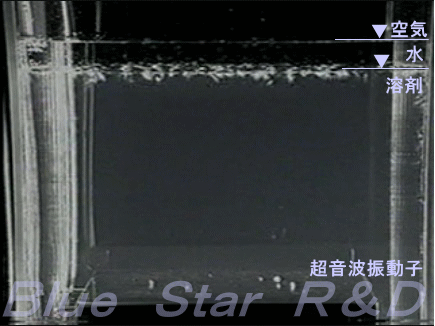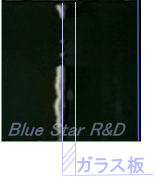1-31-1 Yokoyamadai,
Chuo-ku, Sagamihara City,
Kanagawa pref. 2520241
- Cotnact
- +81-42-7117721
WEB Ultrasonic Cleaning Technology Seminar.
True ultrasonic cleaning technology The origin of ultrasonic deburring technology.
Basic Technology
1.Misconceptions about ultrasonic cleaning technology 2007 State of the art.

Typical ultrasonic cleaning video.
The video you are about to see is a video of ultrasonic radiation on CFC-113 (CFC-113), a typical cleaning solvent of the 20th century.As a reminder, similar images can be seen with almost all cleaning solvents other than water and water-based solvents.Chlorinated organic solvents, brominated solvents, hydrocarbon solvents, higher alcohol solvents, etc. are all basically the same.

There is no such thing.In fact, the air will actually invade and re-dissolve from the liquid surface to the extent that it has been removed by ultrasound.Water is added on top of the hydrophobic solvent and the water creates a zone of relative air blockage.The image on the right shows what happens.If this condition is continued, the amount of air leaving as bubbles is greater than the amount of air entering from the liquid surface, so the air eventually disappears and the bubbles disappear.This is where the real cavity occurs for the first time!Water is emulsified in an instant.

Results of video analysis
- Bubbles generated from the surface of the diaphragm (initially, at various locations in the tank) are air.
→ gas aeration and not the expected cavities. - The bubbles do not collapse in the liquid, but burst at the surface and create droplets.
→The illusion of effective ultrasonic cleaning is created. - After about 10 seconds, numerous air bubbles are generated from the diaphragm surface.
→The ultrasonic waves are absorbed and blocked near the diaphragm surface due to the air bubbles and disappear. - Bubbles persist.
→The bubbles will not disappear unless air ingress from the liquid surface is stopped.
Therefore, this video is not a basic video of ultrasonic cleaning, but a video showing ultrasonic waves being eliminated on the surface of the diaphragm.
The biggest misconception about ultrasonic cleaning
- Bubbles generated from the surface of the diaphragm (initially, at various locations in the tank) are air.
- Visible bubbles in the liquid during ultrasonic oscillation are not cavities (which are expected to have cleaning capacity).
- The visible bubbles are simply air bubbles that act to absorb and block ultrasonic waves.
- If ultrasonic cleaning is to be used correctly, real cavities must be utilised.
2.超音波洗浄とは何か。その正しいの原理の究明
Ultrasonic cleaning is a cleaning method that uses the impact force of cavities (during their creation and collapse) generated by ultrasound.Therefore, in order to understand ultrasonic cleaning, it is necessary to correctly understand the principle of how the individual cavities of the cavitations generated by it are generated and disintegrated, and how the contamination is removed.Ultrasonic cleaning cannot be described if cavities are understood incorrectly.To begin with, let’s see how contamination is removed by ultrasonic cavities by means of a video.The film was taken around 1990.
The animation was hollowed out and animated, so please forgive the shaky base point.The glass is 5 mm thick.The screen frames per thousandth of a second.

Ultrasonic cleaning Principle of dirt removal.
A major reason for the stagnation of ultrasonic cleaning technology over the past 20 years is due to a misunderstanding of the basic understanding of what ultrasonic cleaning is.Ultrasonic cleaning systems have progressed rapidly in accordance with advances in peripheral technologies and customer requirements.Transport technology, instrumentation technology, sheet metal welding technology, etc. …However, there has been no significant change in the basic content of ultrasonic cleaning technology, with only a few exceptions.Even if the appearance and the transport technology evolve, ultrasonic cleaning technology cannot meet the demands of the times if there are no fundamental innovations in the ultrasonic cleaning technology itself.In order to fully utilise innovative ultrasonic cleaning technology for the new era, we must first ask what is ultrasonic cleaning?Why is dirt removed and why not?
A deep understanding of the principles involved and the dispelling of misconceptions are needed.
Principles of ultrasonic cleaning for dirt removal (get it right!)
Ultrasonic cleaning is a cleaning method in which powerful ultrasonic waves are emitted into a liquid and the impact forces generated when cavities are created and extinguished are used.If cavities are not generated, it cannot be said to be ultrasonic cleaning.In other words, ultrasonic cleaning is a technology that uses cavities generated by ultrasonic waves for cleaning.Therefore, a basic requirement for understanding and effectively utilising ultrasonic cleaning is a correct understanding of cavities and the phenomena of their creation and disappearance (cavitation).Powerful sound waves above 20 KHz, i.e. ultrasonic waves, are irradiated into the liquid.When a sound pressure change above a certain level occurs in the liquid, so-called cavities are generated.Cavities consist of a number of vacuum nuclei (microcavities), the overall size of which depends on the frequency and the magnitude of the sound pressure change, but on a practical level is about 100 microns to a few dozen millimetres.
All rights reserved.